14 Best Social Media Automation Tools To Leverage in 2023
We know the struggles of social media managers: juggling multiple accounts, keeping up with content creation, and never quite having enough hours in the day. 🥵 Well, we’ve got your...

For every social media manager, the pressure to stay on top of your content calendar can be overwhelming. With so many followers to engage with and posts to publish, it can easily become a full-time job keeping track of everything. You’re constantly running around trying to come up with something to post, when you should be focusing on other important tasks in your role.
That’s why having a social media content calendar can be a game-changer. A solid social media calendar allows you to plan weeks’ worth of content ahead of time so you don’t have to worry about it day to day.
In this blog post, we’re going to explain why having a social media content calendar is so beneficial and how you can make one that works for you. So if you’re ready, let’s dive right in.
A social media calendar is a document used to plan, schedule, and organize upcoming content for your various social media accounts. Social media calendars include information such as the date of the post, type (photo, link, etc.), any hashtags or mentions you want to include, a brief description of the content, and more.
Having a social media calendar helps social media managers to keep track of multiple social networks, plan consistent social media presence, and run better social media campaigns.
It sounds like a tough task, but creating a content calendar doesn’t need to be complicated.
All you need is some basic knowledge of social media marketing, a fresh look at your current social strategy, and a little bit of time.
Starting without a social media audit is like starting a trip around the world without your passport. You’ll get to the border or to the airport, but you won’t be allowed to move further.
The first step to creating the perfect social media calendar should always be conducting a social media audit: take a look at what content you already have and gauge how it has performed.
This provides insight into what content resonates with your followers, what format keeps your audience engaged and addresses their pain points, as well as other important details such as their locations, habits, and interests.
This audit is essential as it will help you determine what is already working and what isn’t.
You can delve into analytics, measure engagement, and look at competitors to give yourself a better understanding of what to post on your social channels.
Your audit should be as data-driven as possible. While you might have some sentiment towards certain topics, the numbers don’t lie. It’s better to stick to trusted social media efforts than put all your money into venturing into uncharted waters with an untested topic.
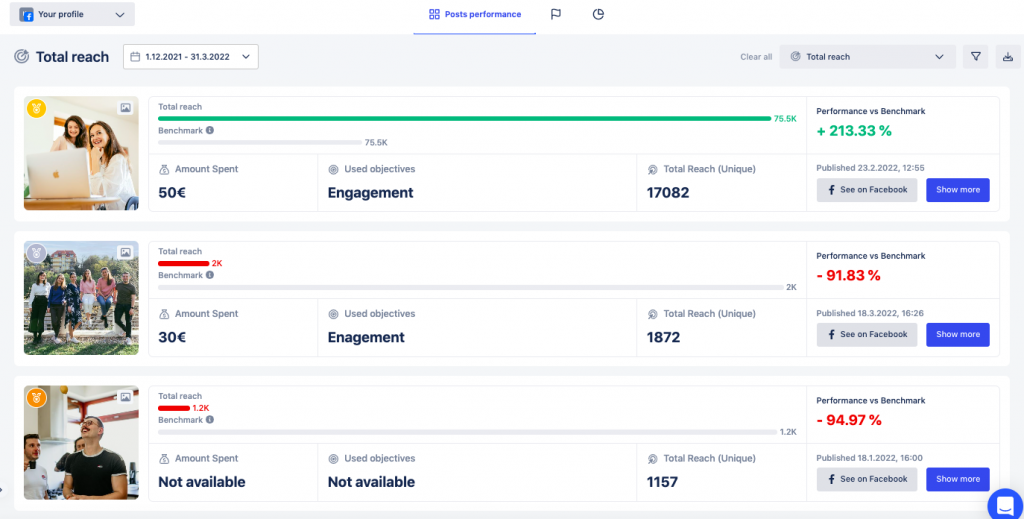
The main metrics you should be paying attention to are:
However, you can and should measure other aspects, depending on your business goals.
Deciding which channels are best for your social presence can be tricky — you only have 24 hours a day, and you need to invest this time and energy wisely.
Weigh up the pros and cons of each social platform: reach, functionality, audience preference, and cost are key considerations when making this decision.
Research what has worked well for similar companies or organizations in the past. Pay attention to the analytics to demonstrate which platforms should be up for a task for reaching your particular marketing goals.
In this step, you also need to ensure that you don’t spread yourself too thin – pick social platforms that you already use and are confident in utilizing or providing the highest engagement levels.
Again, this is where you put your personal preferences aside and focus on the data. Also, you should match it with your resources. This means that if you want to run marketing campaigns on, say, five new social media platforms, but your social team consists of only three people, this task might be unmanageable.
Content calendar inputs for your posting strategy can be bottomless. The most important aspect is to find balance between what your audience wants to see and what you want to promote. Then, your social media content calendar will act as a roadmap to plan and schedule your posts in advance.
You can start from one single document and build a whole suite of systems or sheets (read on for a solution for that), or end up using social media calendar tools to help you with this task.
Below, you’ll find a few ideas for elements of your social content calendars:
Depending on your goals, there may be other inputs that are useful for you, such as influencer links, or UTMs/link tracking codes.
If you’re a lone social media marketer, then you might be able to manage the content on your own, at least to some extent. But if you’re part of a team or an agency managing multiple social media accounts, it can become more complex.
That’s why you need to work on team collaboration requirements and rules within your social media calendar. These would apply to both your internal processes and external approval rounds with your client.
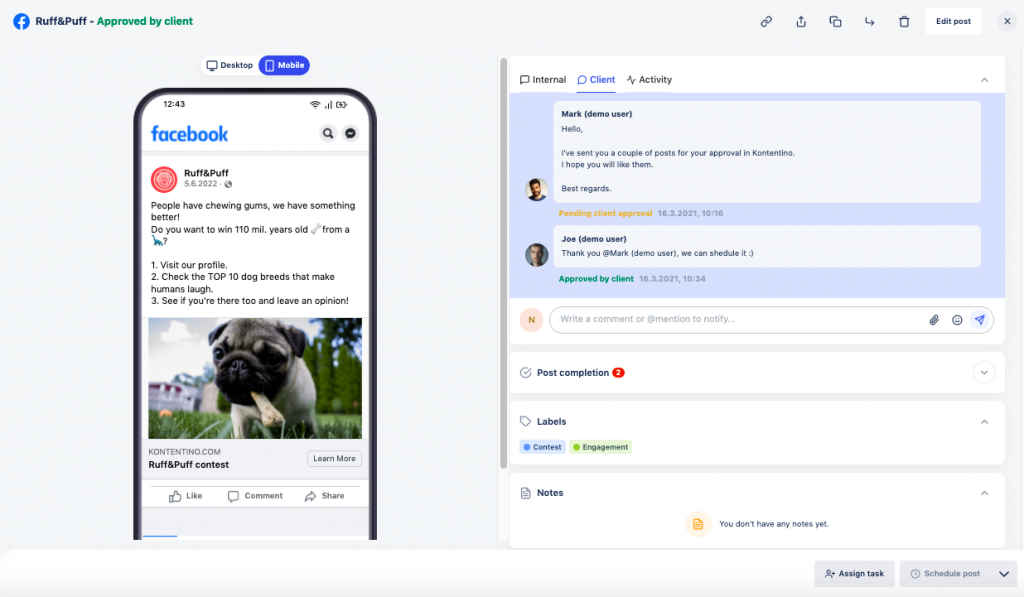
Everyone should have visibility over:
This is especially critical for social media managers who work remotely or manage multiple accounts. Get all of your team members on the same page in terms of content ideas and communicate clearly what the expectations or deadlines are for each task.
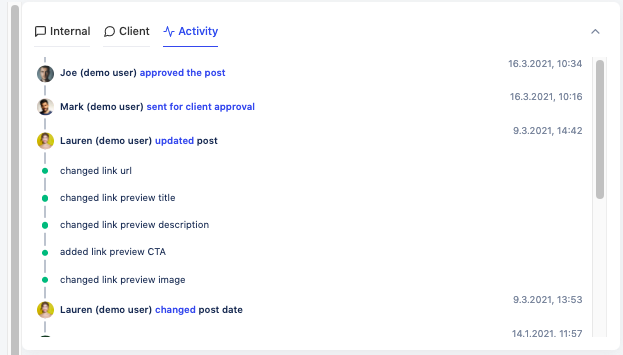
You can introduce numerous rules and processes that are specific to your team. It’s also key to be flexible and confirm that everyone understands the purpose of each process so they can adapt quickly if needed. It’s better to start slowly and increase the complexity of your processes step by step.
Evaluate the resources and assets you already have – many elements of your social media content calendar may simply wait to be used or repurposed.
Organize all these elements into a library of resources that you can easily access when needed.
Start organizing your assets by gathering elements such as:
While this is just a starting point, you can get creative to find other elements that may be useful.
Always track the performance of your social media marketing efforts to optimize your social media calendars and increase ROI.
Use social media analytics tools to produce automated reports and insights that inform your decisions. These will show you which content works better with your audience and offers more value.
Analyzing performance can help you adjust the components of your social media calendar, such as the types of content you produce, the timing and frequency of your posts, or the influencers you decide to work with.
If you need some kind of benchmark to compare against, a span of three months between analyzing and optimizing should be enough here.
This means that every three months:
Rinse and repeat.
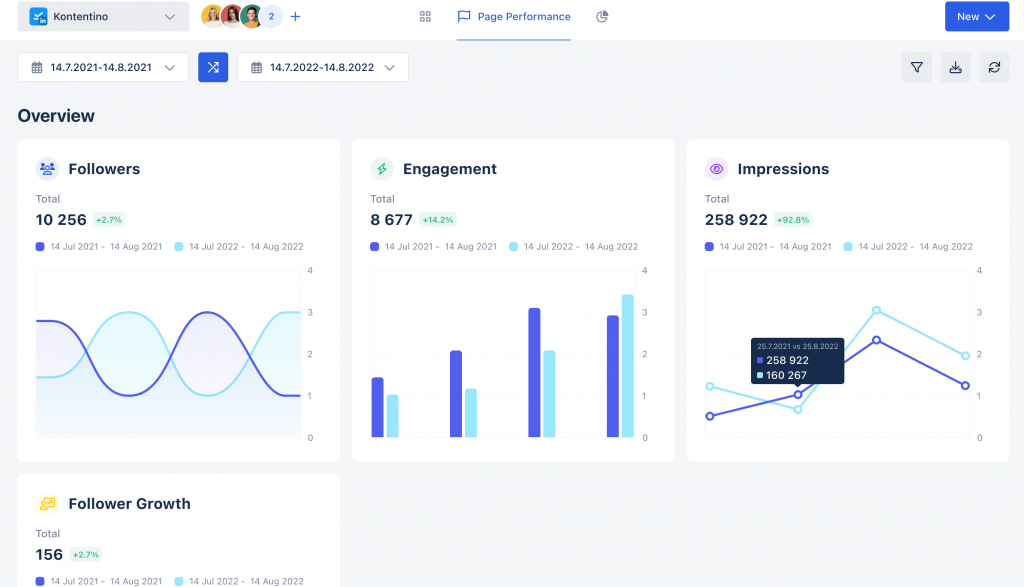
If you notice some post ideas particularly resonate with your audience or if there are relevant content trends to hop on right away, tweak your social calendar as you go without waiting for the next “evaluation period”.
The sooner you test your ideas, the sooner you get to see the results (and beat your competitors).
We’ve created a special social media content calendar template for social media teams to follow, adjust, and use in their own social media content creation process.
Looking for the best social media calendar for a digital agency? Look no further.
Kontentino isn’t just a social media content calendar template. It’s way more than that.
With Kontentino, social media marketers can bring social media content from concept to completion with ease. From finding inspiration, through creating content and optimizing it for different platforms, to receiving client approval, scheduling posts, and analyzing the results – all in a single intuitive dashboard that works wherever you are.
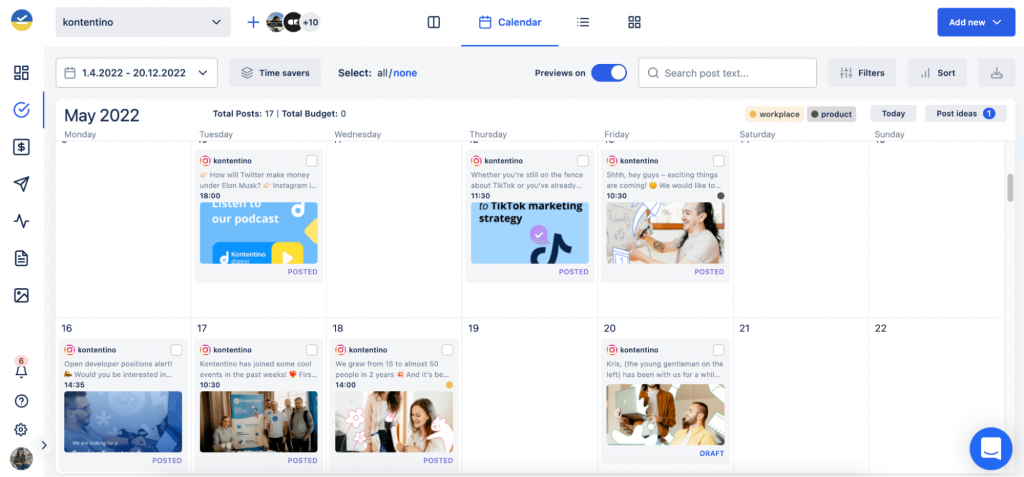
In a social media content calendar itself, you can:
Apart from creating and curating your social media content calendar, Kontentino can help you with:
Think of Kontentino as your very own marketing wizard! 🪄
This powerful social media management tool lets you cast a content spell to conjure up an amazing social media posting schedule that engages your audience. Create custom calendar templates, collaborate within marketing teams, and approve posts quickly, gain insights into performance, and more.
Start your free trial and build your posting calendar now.
Google Sheets are free to use and always available in the cloud, so you and your team can access them anywhere, anytime. If you’ve ever used spreadsheets, a social media content calendar created in Sheets should be intuitive to set up, use, and share with your team.

Google Sheets lack a couple of features that make social media publishing a bit easier, though. For example, you don’t have the ability to quickly drag & drop posts from one day to another without copying-pasting your data.
Sending tasks for approval can only be done via comments with tagging, which can get a bit messy when it comes to a posting schedule for multiple social posts or social channels. Moreover, you can’t publish posts directly to your social media profiles, so it’s not a social media tool per se.
Google Sheets is a cost-efficient way to plan content on social media, especially if you’re just starting out in the game, but might not cut it if your social media management process has become complex.
Trello is one of the most popular project management tools out there, and it’s widely used for creating social media content calendars as well. However, Trello is not necessarily a true social media calendar tool.
It’s more of a board-based system with columns and cards that can be dragged around the board in whatever way you see fit. For social media content creation, it can be helpful, but it doesn’t have all of the features provided by social media calendar tools.
Trello doesn’t offer pre-set or built-in social templates, so it’s up to you to create the social media calendar template and layout. This makes Trello more versatile in terms of creating custom boards with lists, labels, and task management tools, but not merging it with social media platforms or direct planning for future posts.
To get you started on the right foot with your publishing schedule, here are some examples of social media calendars that could help you plan your campaigns in a more organized fashion:
Creating a social media content calendar is one thing, but actually filling it in and keeping the momentum is a different story. You need to remember many elements, track and monitor your social media campaigns’ performance, and, on top of that, focus on content creation with a specific objective in mind.
But if you manage to stay consistent with your social media strategy and stick to the content plan, you can reap all of the benefits that come with having a social media calendar.